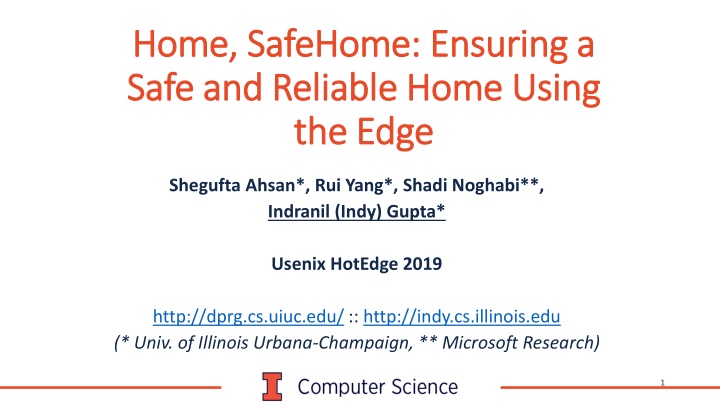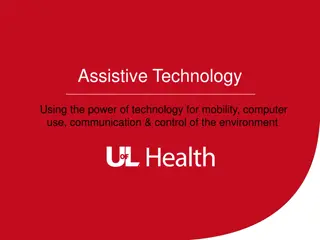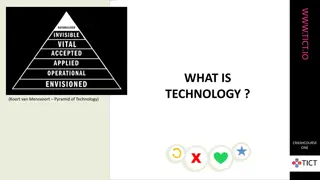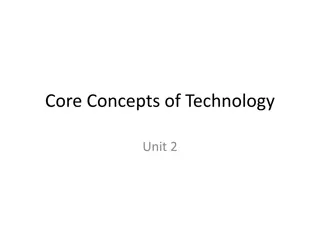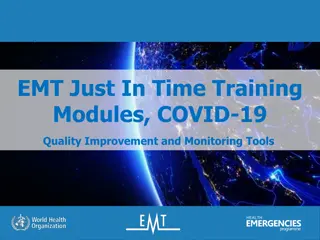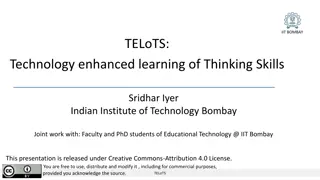Ensuring a Safe and Reliable Home Using Safe and Reliable Technology
Today's smart homes present challenges in managing IoT devices and ensuring safety. This article discusses manual control issues, concurrency conflicts, and a software-defined approach called SafeHome that improves home management and safety.
Uploaded on Mar 11, 2025 | 0 Views
Download Presentation

Please find below an Image/Link to download the presentation.
The content on the website is provided AS IS for your information and personal use only. It may not be sold, licensed, or shared on other websites without obtaining consent from the author.If you encounter any issues during the download, it is possible that the publisher has removed the file from their server.
You are allowed to download the files provided on this website for personal or commercial use, subject to the condition that they are used lawfully. All files are the property of their respective owners.
The content on the website is provided AS IS for your information and personal use only. It may not be sold, licensed, or shared on other websites without obtaining consent from the author.
E N D
Presentation Transcript
Home, Home, SafeHome SafeHome: Ensuring a Safe and Reliable Home Using Safe and Reliable Home Using the Edge the Edge : Ensuring a Shegufta Ahsan*, Rui Yang*, Shadi Noghabi**, Indranil (Indy) Gupta* Usenix HotEdge 2019 http://dprg.cs.uiuc.edu/ :: http://indy.cs.illinois.edu (* Univ. of Illinois Urbana-Champaign, ** Microsoft Research) 1
1. How many of you have IoT devices in your (smart) home? 2. How many of you use the same app (on your mobile device) to control MORE than 1 of the IoT devices in your smart home? 3. How many of you use the same app to control ALL the IoT devices in your smart home? 2
Smart Homes Smart Homes All media are extensions of some human faculty -- psychic or physical. -- Marshall McLuhan. Not true in smart homes/buildings today! 1. Users today control smart homes and buildings in a largely manual style. Users directly control devices, e.g., via mobile Imperative programming (e.g., Routine = Sequence of Commands) comes with correctness issues 2. Additionally, Humans today manually ensure that safety properties are not violated. Stove is ON => Exhaust fan is ON House LOCKED => Security cameras ON ATMOST (1)(South Lawn Sprinklers, North Lawn Sprinklers) 3
The State Today The State Today Routines (sequences of commands) that are concurrent can conflict with each other, creating inconsistent outcomes and unsafe states Humans cannot reason about concurrency at millisecond-level Erroneous routines may violate Safety Properties Switch OFF Exhaust Fan; Switch ON Stove; Failures of devices have unintended consequences and result in inconsistent outcomes and unsafe states 4
Two Concurrent Routines Two Concurrent Routines R2 starts soon after R1 More final states are inconsistent SafeHome s goal: Bring all lines down to horizontal axis Worse with longer routines Routines R1 and R2 run on (X-axis) TP-Link HS105 smart plugs. R1 turns on all lights, then R2 turns off all lights. Times above (ms) show time gap from R1 start to R2 start. 5
SafeHome SafeHome A software-defined management approach for smart home management. Features: 1. Users specify home-wide Safety properties in a declarative way SafeHome ensures these all the time (disallows or aborts routines that violate) 2. Users can imperatively program routines 3. SafeHome Autonomously catches and responds to concurrency conflicts, safety violations, and failures. 4. Modular design 5. Sits on edge, and works with commodity devices and APIs (no modifications of device) 6. Avoids putting logic on cloud, which would have increased latency and violated privacy 6
ASID Challenges ASID Challenges A: SafeHome-Atomicity. Execution of a routine is atomic and exactly-once. When a routine finishes, either: a) all its commands have been executed successfully, or b) none of its commands have had an effect on the smart home. Challenges: a) catching conflicts, b) aborting routines, c) undo-ing routines. S: SafeHome-Safety. User-specific Safety properties are satisfied at runtime. Challenges: a) Safety properties span multiple devices, b) catching these at run-time. I: SafeHome-Isolation. Concurrent routines are isolated from interfering with each other at devices. Challenges: If routines interfere, SafeHome must ensure the execution is serially equivalent. D: SafeHome-Durability. A routine that completes successfully cannot be undone (except by another subsequent routine). Challenges: No undo after commit point of routine. 8
Safety Properties: Safety Properties: SafeHome s SafeHome s Grammar Grammar This is a first-cut grammar. Surprisingly, captures a wide swathe of safety specifications.
Safety Specifications: Examples Safety Specifications: Examples Undesirable State Desirable Safety Property IF (stove==ON)THEN(exhaust-fan==ON) Routine R1 turns on both stove and exhaust-fan, but then Routine R2 turns off exhaust-fan. IF (air-cond==ON) THEN (windows==CLOSED) IF (dishwasher==on) THENATMOST(1) (washingmachine==ON, dryer==ON) Routine R1 opens a window, Routine R2 turns on air- conditioner. Power overload due to multiple heavy devices. Turning on all sprinklers around the house leads to insufficient water pressure. ATMOST(1) (Northeast-sprinkler=ON, Northwest-sprinkler=ON, Southeast-sprinkler=ON) IF (garage-door.OPEN > `n' hours) THEN(garage-door==CLOSE) User accidentally leaves garage-door open overnight.
Failures and Safety Failures and Safety Safety properties are impossible to guarantee always Stove and Exhaust fan are both ON Exhaust fan fails SafeHome ensures safety properties are invalid for at most a tolerance window (after a failure) Could be set by user or physical constraints (e.g., reboot time) SafeHome uses tolerance window to set timeout in its failure detector algorithm 11
Where it Where it Really Really Gets Interesting (1/2) Gets Interesting (1/2) I. ASID@IoT Mechanisms can borrow heavily from ACID@Database mechanisms. But key differences: ASID@IoT optimizes latency and abort rate, while ACID@DB optimizes throughput and abort rate. Intermediate states in ASID@IoT are almost always visible to user (may not be in ACID) Undo of routine needs to have consolidated action across affected devices Long-running routines exist in ASID@IoT (rarer in ACID) Run North Sprinklers for 15 minutes; Run South Sprinklers for 20 minutes; Challenges: a) Interaction between long-running and short-running (instant) routines; b) Interaction among long-running routines. Human Interrupts, Exceptions, Pauses Concurrency Control: Optimistic vs. Pessmistic Approaches 12
Where it Where it Really Really Gets Interesting (2/2) Gets Interesting (2/2) II. Safety Checking can borrow from Static and Dynamic Type Checking in Compilers/Programming Languages. But: Dynamic checking need to deal with a) concurrent routines, b) failed devices that may or may not recover (optimistic abort vs. pessimistic abort) III. Interesting dilemmas Goto Dilemma: Should the default state (after-failure reboot) for garage door be OPEN or CLOSED? OPEN = Hello, Burglars! CLOSED = Door closes on a car underneath it. Also occur in self-driving cars (Tesla Model S fatality May 2016, Ohio) 13
Feedback/Controversial/Open Qs/Fall Apart Feedback/Controversial/Open Qs/Fall Apart Latency Biggest need, and main reason for system to fall apart: it s too slow! DB ACID consistency literature: useful? How deep? (our focus: Latency) User involvement UI: Need an easy UI for specifying safety properties, and for programming routines. Is ASID behavior (esp. abort and undo) cumbersome to user? Cannot (always) require human intervention. E.g., deadlocks, safety violations. Device Resources: SafeHome assumes no extra capability or memory on devices. With more capable devices: More capable devices can be used for failure recovery when edge is down, eliminating cloud reliance. Such smart devices can serve as failover for edge device (run SafeHome logic). ACID: Downsides? 14
SafeHome SafeHome A software-defined management approach for smart home management. Features: 1. Users specify home-wide Safety properties in a declarative way SafeHome ensures these all the time (disallows or aborts routines that violate) 2. Users can imperatively program routines 3. SafeHome Autonomously catches and responds to concurrency conflicts, safety violations, and failures. 4. Modular design 5. Sits on edge, and works with commodity devices and APIs (no modifications of device) 6. Avoids putting logic on cloud, which would have increased latency and violated privacy 15
Backup Slides Backup Slides 16
SafeHome SafeHome Architecture Architecture
Definitions Definitions Term Definition device a smart home device with a set of potential states command a user/program triggered instruction that changes the state of an individual device routine a sequence of commands Safety properties guaranteed device behaviors that user expects from the smart home
People: Needs & Wants Intelligent Infrastructures Future of People A. Future of Health 1. FAT: Fairness, Accountability, Transparency, Bias, Individual/group I. Social Media B. Future of Relationships II. Intelligent Web 2. I.E.: Interpretability, Explainability Systems Researchers Need to do this more! C. Future of Employment (job finding, task matching, team making) III. IoT Smart cities, Smart vehicles, Smart* 3. Democratization: Equality, Equity V. Energy Oil, Gas, Nuclear D. Future of Transportation IV. Finance 4. Education VI. Utilities E. Future of News 5. Legal e.g., GDPR, HIPAA F. Future of Agriculture VII. Materials & Manufacturing G. Future of Communities VIII. Healthcare 6. Ethics IX. Supply-Chain H. Future of Markets 7. Declarative Programming I. Future of Data Analytics Systems Researchers Do These Very well! X. Internet & Telecom 8. Security Privacy, Confidentiality, Integrity XI. Datacenters & Clouds J. Future of Programming 9. Reliability K. Future of Research XII. Defense 10. Scale & Fault-tolerance L. Future of Peace
